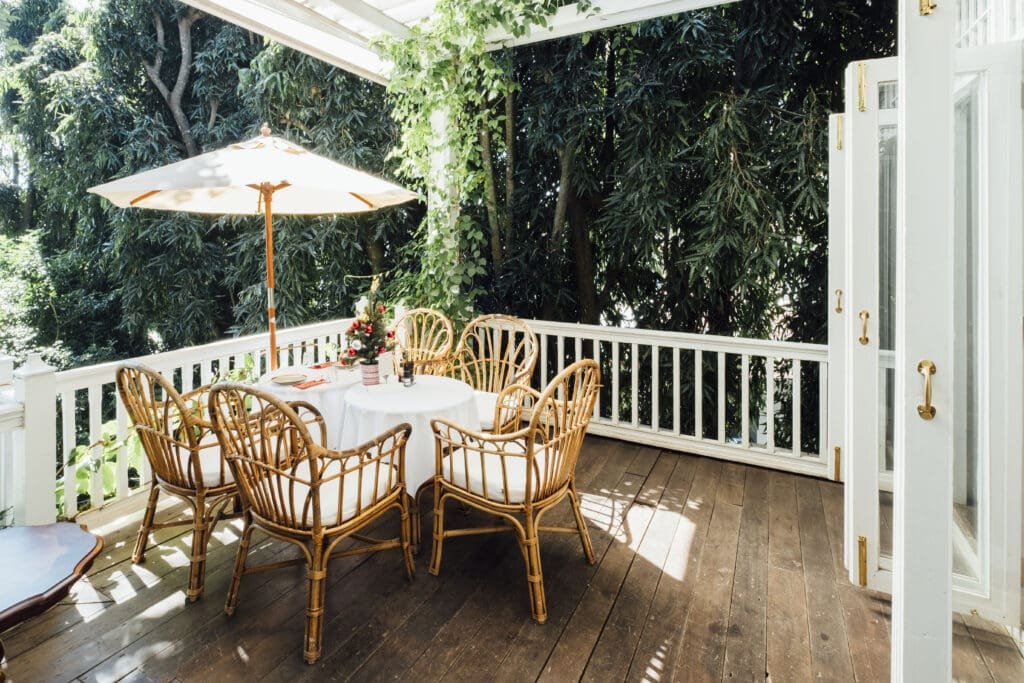
Deck Resurfacing vs Replacement in Terre Haute: 2025 Costs, Red Flags, and What Lasts
If your frame is sound and to code, resurfacing with capped composite or PVC is usually the lowest lifetime cost in Indiana. Replace the deck when you see rot, shallow/heaved footings, loose rails, or plan layout changes. Typical 2025 ranges in Terre Haute: resurfacing ~$25–$55/sq ft (composite/PVC) vs full replacement ~$40–$90+/sq ft.
Before you compare wood vs composite, confirm the structure. In Terre Haute and west-central Indiana, freeze–thaw, humidity, and summer sun wear decks fast. This guide shows when resurfacing makes sense on a sound, code-compliant frame, when full replacement is safer and cheaper long-term, realistic 2025 costs, and which materials actually hold up here.
Key Takeaways
- Resurface when the frame is sound and code-compliant; replace for rot, wobbly rails, or heaved/shallow footings
- In Indiana weather, capped composite or PVC on a solid frame gives the best long-term value with the least maintenance
- Railings, stairs, and framing repairs swing the budget more than deck boards; 2025 ranges: ~$25–$55/sq ft to resurface vs ~$40–$90+/sq ft to replace
- A quick structural check (posts, beams, ledger, hardware) plus footings at/below local frost depth is the fastest way to decide
- Typical timeline: 2–5 days to resurface vs 1–2+ weeks for full replacement
- Safety first: loose rails, soft spots, or ledger issues = replacement before new boards
Quick Answer: Resurface Vs Replace
If the structure is sound and to code, resurfacing with capped composite or PVC is usually the lowest lifetime cost. Replace when the structure is compromised or you want to change the layout.
Resurface If ALL Of These Are True:
- Posts are plumb; beams/joists are solid with no rot, splits, or bounce
- The ledger is properly flashed and fastened with structural screws, no signs of moisture damage
- Footings extend to at/below local frost depth with no heaving or settling
- You’re keeping the same layout, stairs, and railing locations
Replace If ANY Of These Are True:
- Rot, insect damage, undersized/notched members, or excessive deflection
- Heaved or shallow footings, post movement, or a deck that’s out of level
- Loose or non-compliant railings/stairs that won’t meet current code
- Ledger rot, improper attachment, or missing flashing against the house
- You’re changing footprint, adding a roof/cover, or relocating stairs
- Joist spacing/ventilation won’t meet composite/PVC requirements
How To Decide In Terre Haute’s climate (6 steps)
- Inspect the structure: Check posts, beams, joists, ledger, and hardware for rot, splits, corrosion, or bounce. Probe suspect spots; notched or undersized members point to replacement.
- Verify footings: Aim for at/below local frost depth (often ~30–36″). Any heave, tilting, settlement, or shallow piers usually means rebuild.
- Confirm ledger and water management: Ledger must be properly flashed and fastened with structural screws/bolts. Fix drainage and splash-back before new boards.
- Check ventilation and clearance: Close-to-grade or shaded decks trap moisture. Ensure airflow and adequate ground clearance; address trapped debris and consider joist tape.
- Evaluate rails and stairs: Wobbly or non-compliant rails, weak stringers, or planned stair/layout changes often tip the decision to full replacement.
- Match materials and get a written estimate: Composite/PVC for low upkeep; hardwood/modified wood for a natural look. Confirm joist spacing/fastener compatibility for your chosen boards, and get an itemized estimate that includes rails, stairs, disposal, and any structural corrections.
2025 Deck Costs In Terre Haute
Budget ranges depend on scope and materials. Resurfacing keeps the existing frame and swaps surface components; replacement rebuilds structure and boards from the posts up.
What Drives Cost
- Material choice: capped composite/PVC vs pressure-treated or hardwood
- Rail systems: composite/metal rails add the most per linear foot
- Stairs: straight runs are cheaper than switchbacks, landings, or wide entries
- Height/complexity: second-story decks, angles, borders, and patterns raise labor
- Prep/disposal: demo, haul-off, ledger cleanup, and site access affect time
- Structural fixes: new footings, joist repairs, and code updates (ledger, rails, stairs)
Realistic Ranges
- Resurfacing (wood): ~$15–$40/sq ft
- Resurfacing (composite/PVC): ~$25–$55/sq ft
- Full replacement (new frame + boards): ~$40–$90+/sq ft
- Example (12×16 = 192 sq ft): composite resurfacing ~$4,800–$10,600; full replacement ~$7,700–$17,300+
Resurfacing Vs Replacement At A Glance
| Factor | Resurfacing | Replacement |
|---|---|---|
| When it’s smart | Frame is sound and to-code | Rot, wobble, shallow footings, layout changes |
| Typical cost (2025) | $25–$55/sq ft (composite/PVC) | $40–$90+/sq ft |
| Timeline | 2–5 days | 1–2+ weeks |
| Upkeep | Low with composite/PVC | Depends on materials; new frame extends life |
| Code upgrades | Often rails/stairs only | Full current-code compliance |
| Best for | Solid structure, budget control | Long-term fix, major improvements |
Red Flags That Mean Replace
- Ledger failure: missing flashing, rot at the house connection, improper fasteners, or separation
- Structural damage/undersizing: rot in posts, beams, or joists; notched or undersized members; insect damage
- Footings/foundation issues: above frost depth (~30–36″), heaving, settling, or tilt
- Excessive movement: bounce, racking, out-of-level/out-of-square framing; loose or corroded connectors/hardware
- Rail/stair code problems: wobbly guards/handrails, weak stringers, heights/spans that won’t meet current code
- Environment/layout constraints: frame too close to grade with trapped debris and poor airflow, chronic moisture issues, or planned major layout changes
When resurfacing is a smart move
- Frame is square, stiff, and code-compliant; no rot or insect damage; joist spacing meets composite/PVC requirements
- Footings are at/below local frost depth (~30–36″) and posts are plumb with no heave or settlement
- Ledger is properly flashed and structurally fastened—or can be upgraded without reframing
- You’re keeping the same footprint, stair locations, and rail layout (no new roof/cover or heavy added loads)
- You want low-maintenance surfaces (capped composite/PVC) and modern rails; plan joist tape/drip edges for longevity
- Ventilation/clearance is adequate (not tight to grade), and add-ons like lighting, fascia, or skirting are cosmetic; timeline fits a 2–5 day resurfacing
Best Materials For Resurfacing In Indiana Weather
Indiana’s freeze–thaw, humidity, and summer UV reward stable, low-maintenance boards. Capped composite is the best all-around pick; PVC shines in damp/shaded yards; dense hardwoods and modified woods look premium if you ventilate well; aluminum is ultra-durable and can keep patios dry; pressure-treated pine is the budget option but needs regular sealing. Follow manufacturer specs for gapping, joist spacing, and fasteners to prevent cupping or movement.
Material picks
- Capped composite: best long-term value in freeze–thaw and humidity; hard cap resists stains/fade; works with hidden fasteners
- PVC: top choice for shade/moisture; extremely rot-resistant; mind thermal expansion and pick lighter colors for cooler surfaces
- Dense hardwoods (ipe/cumaru): premium look/feel; pre-drill, use stainless fasteners, and ensure strong ventilation and drainage
- Modified woods (thermally/acetylated): natural wood aesthetic with improved stability over softwoods; finish annually for color retention
- Aluminum systems: ultra-durable, non-combustible, and water-shedding; great for second-story decks to create dry space below
- Pressure-treated pine: lowest upfront cost; requires diligent sealing/maintenance and careful detailing to avoid early ro
Maintenance & Lifespan You Can Plan Around
On a sound frame, you can budget maintenance by material and expect the ranges below in Indiana’s freeze–thaw, humidity, and summer sun.
Expected Lifespan & Care
- Capped composite: ~25–30 years; no sealing; soap-and-water clean 2x/year; check hidden fasteners every 5–7 years
- PVC: ~25–35 years; no sealing; clean 2x/year; mind expansion gaps and use lighter colors to stay cooler underfoot
- Aluminum: ~30–50 years; rinse 1–2x/year; inspect gaskets/drainage if using a water-shedding system; touch up scratches to protect finish
- Dense hardwoods (ipe/cumaru): ~25–40 years with proper detailing; clean 2x/year; oil 1–2x/year if you want to preserve color; always use stainless fasteners and good ventilation
- Modified woods (thermally/acetylated): ~20–30 years; clean 2x/year; apply penetrating finish annually for color retention; maintain end-seal cuts
- Pressure-treated pine: ~10–20 years (shorter if low ventilation); clean 2x/year; re-seal every 2–3 years with a breathable penetrating finish; avoid film-forming coatings
Simple Habits That Extend Life
- Keep board gaps clear; deep-clean in spring and fall
- Use joist tape on framing, proper ledger flashing, and corrosion-resistant hardware
- Maintain airflow (vented skirting, adequate ground clearance) to prevent trapped moisture
- Use furniture pads and move planters/grills occasionally to avoid abrasion and staining
Frequently Asked Questions On Deck Resurfacing & Replacement In Terre Haute
Can I resurface if there’s a little rot?
No—repair or replace any damaged members first. Resurfacing only makes sense on a sound, code-compliant frame.
How long does resurfacing take compared to replacement?
Resurfacing typically wraps in 2–5 days. Full replacement usually takes 1–2+ weeks depending on size, rails, inspections, and site conditions.
Can I keep my existing railings when I resurface?
Sometimes, but upgrading during resurfacing often improves safety, meets current code, and refreshes the look. Many composites pair best with matching rail systems.
Do I need a permit to resurface in Terre Haute?
Often, yes—especially if rails, stairs, or structure change. When in doubt, check before starting; we guide clients through local requirements.
What lasts longest with the least maintenance in Indiana?
Capped composite or PVC on a sound frame—no sealing, just periodic cleaning.
Will my current framing work with composite/PVC boards?
Usually—if joist spacing meets manufacturer specs (often 16″ OC; sometimes 12″ for angles/partials), ventilation is adequate, and you use compatible fasteners.

Need further assistance?
Unsure about something? Get in touch with us for a personalized consultation.
Deck Experts in Terre Haute—Free On-Site Assessment
Not sure if the frame is worth keeping? We’ll check posts, ledger, and rails and deliver an itemized quote for both paths. Warranty and references available.
Serving Terre Haute, Clinton, Rockville, and surrounding areas.